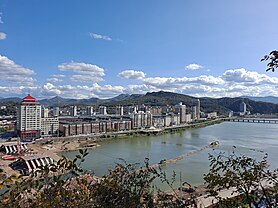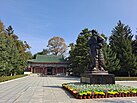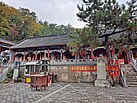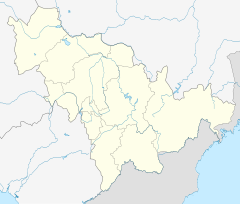This article needs additional citations for verification. (July 2009) |
Tonghua (Chinese: 通化; pinyin: Tōnghuà) is a prefecture-level city in the south of Jilin province, People's Republic of China. It borders North Korea's Chagang Province to the south and southeast, Baishan to the east, Jilin City to the north, Liaoyuan to the northwest, and Liaoning province to the west and southwest. Its population was 1,812,114 registered residents at the 2020 census living in an area of 15,195 square kilometres (5,867 sq mi). Its built-up (or metro) area made of the two urban districts was home to 446,917 inhabitants. It is known as one of the five medicine production centres in China.[3]
Tonghua
通化市 T'ung-hua | |
|---|---|
From top, left to right: View from Yuhuang Mountain; Night Street in Dongchang; Tonghua Science and Culture Center; Yang Jingyu Memorial Park; Yuhuang Temple | |
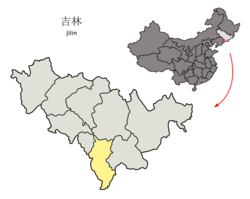 Location of Tonghua City (yellow) in Jilin (light grey) and China | |
| Coordinates (Tonghua government): 41°43′42″N 125°56′23″E / 41.7283°N 125.9397°E | |
| Country | People's Republic of China |
| Province | Jilin |
| County-level divisions | 7 |
| Municipal seat | Dongchang District |
| Government | |
| • Type | Prefecture-level city |
| • CPC Tonghua Secretary | Liu Baowei (刘保威) |
| • Mayor | Tian Yulin (田玉林) |
| Area | |
| 15,195 km2 (5,867 sq mi) | |
| • Urban | 761 km2 (294 sq mi) |
| • Metro | 761 km2 (294 sq mi) |
| Elevation | 374 m (1,227 ft) |
| Population (2020 census)[1] | |
| 1,812,114 | |
| • Density | 120/km2 (310/sq mi) |
| • Urban | 446,917 |
| • Urban density | 590/km2 (1,500/sq mi) |
| • Metro | 446,917 |
| • Metro density | 590/km2 (1,500/sq mi) |
| GDP[2] | |
| • Prefecture-level city | CN¥ 100 billion US$ 16.1 billion |
| • Per capita | CN¥ 45,171 US$ 7,252 |
| Time zone | UTC+8 (China Standard) |
| Postal code | 134000 |
| Area code | 0435 |
| ISO 3166 code | CN-JL-05 |
| Licence plate prefixes | 吉E |
| Website | tonghua |
| Tonghua | |||||||||
|---|---|---|---|---|---|---|---|---|---|
 "Tonghua", as written in Chinese | |||||||||
| Chinese | 通化 | ||||||||
| Postal | Tunghwa | ||||||||
| |||||||||
History
editHuman settlement in the Tonghua area dates from about 6,000 years ago.[4] In the Western Han Dynasty, Tonghua belonged to the Liaodong Fourth Commandery (遼東四郡).
Tonghua was the birthplace of Goguryeo culture and shaman culture.[4] The Goguryeo kingdom established its capital at Gungnae in 425 A.D., which, together with the Tombs of the Ancient Gogoryeo Kingdom, represents the only successful, independent submission to become a UNESCO World Heritage Site.[4][5]
Under the Japanese occupation of Manchuria after 1932, a railway was constructed linking Tonghua with the main Manchurian rail network and with northern Korea.
During the Second Sino-Japanese War, Yang Jingyu led the First Army of the Northeast Anti-Japanese United Army to battle the Imperial Japanese Army, and was killed in battle.[4][5]
In August 1945 Tonghua briefly served as the temporary capital of Manchukuo, where Puyi claimed to abdicate at the behest of the Kwantung Army. In 1985, Tonghua became a prefecture-level city under the approval of the State Council.[6]
The city has a recent record of extreme violence including the Shosankoku incident in 1945, the Tonghua Incident in 1946 and the Tonghua Iron and Steel Group riot in 2009.
Administrative divisions
edit| Map | ||||||
|---|---|---|---|---|---|---|
| # | Name | Hanzi | Hanyu Pinyin | Population (2010 est.) | Area (km2) | Density (/km2) |
| 1 | Dongchang District | 东昌区 | Dōngchāng Qū | 360,195 | 383 | 940 |
| 2 | Erdaojiang District | 二道江区 | Èrdàojiāng Qū | 146,682 | 378 | 388 |
| 3 | Meihekou City | 梅河口市 | Méihékǒu Shì | 615,367 | 2,175 | 283 |
| 4 | Ji'an City | 集安市 | Jí'ān Shì | 232,358 | 3,408 | 68 |
| 5 | Tonghua County | 通化县 | Tōnghuà Xiàn | 247,225 | 3,729 | 66 |
| 6 | Huinan County | 辉南县 | Huīnán Xiàn | 359,453 | 2,277 | 158 |
| 7 | Liuhe County | 柳河县 | Liǔhé Xiàn | 363,962 | 3,348 | 109 |
Geography
editClimate
editTonghua has a monsoon-influenced, humid continental climate (Köppen Dwa), with long, very cold, windy, but dry winters and hot, humid summers; spring and autumn are brief. The monthly 24-hour average temperature ranges from −13.9 °C (7.0 °F) in January to 22.3 °C (72.1 °F) in July; the annual mean is 6.0 °C (42.8 °F). During the warmer months, rainfall is enhanced by the mountainous topography, allowing for a generous annual precipitation total of 893.44 millimetres (35.2 in). However, the monsoon still means that more than 60% of the annual precipitation falls from June to August alone.
| Climate data for Tonghua, elevation 403 m (1,322 ft), (1991–2020 normals, extremes 1971–2010) | |||||||||||||
|---|---|---|---|---|---|---|---|---|---|---|---|---|---|
| Month | Jan | Feb | Mar | Apr | May | Jun | Jul | Aug | Sep | Oct | Nov | Dec | Year |
| Record high °C (°F) | 4.7 (40.5) |
12.6 (54.7) |
18.2 (64.8) |
28.7 (83.7) |
32.3 (90.1) |
34.9 (94.8) |
35.6 (96.1) |
35.3 (95.5) |
30.7 (87.3) |
26.4 (79.5) |
18.3 (64.9) |
8.9 (48.0) |
35.6 (96.1) |
| Mean daily maximum °C (°F) | −6.1 (21.0) |
−1.6 (29.1) |
5.4 (41.7) |
14.7 (58.5) |
21.5 (70.7) |
25.4 (77.7) |
27.8 (82.0) |
27.1 (80.8) |
22.3 (72.1) |
14.6 (58.3) |
4.0 (39.2) |
−4.3 (24.3) |
12.6 (54.6) |
| Daily mean °C (°F) | −13.3 (8.1) |
−8.5 (16.7) |
−0.6 (30.9) |
8.2 (46.8) |
14.9 (58.8) |
19.6 (67.3) |
22.8 (73.0) |
21.6 (70.9) |
15.3 (59.5) |
7.4 (45.3) |
−1.8 (28.8) |
−10.5 (13.1) |
6.3 (43.3) |
| Mean daily minimum °C (°F) | −18.8 (−1.8) |
−14.3 (6.3) |
−5.8 (21.6) |
2.3 (36.1) |
8.8 (47.8) |
14.6 (58.3) |
19.0 (66.2) |
17.8 (64.0) |
10.6 (51.1) |
1.9 (35.4) |
−6.4 (20.5) |
−15.6 (3.9) |
1.2 (34.1) |
| Record low °C (°F) | −33.4 (−28.1) |
−31.8 (−25.2) |
−27.6 (−17.7) |
−12.8 (9.0) |
−3.8 (25.2) |
5.2 (41.4) |
10.3 (50.5) |
5.0 (41.0) |
−2.8 (27.0) |
−11.5 (11.3) |
−25.3 (−13.5) |
−32.1 (−25.8) |
−33.4 (−28.1) |
| Average precipitation mm (inches) | 8.4 (0.33) |
14.7 (0.58) |
23.9 (0.94) |
49.2 (1.94) |
82.7 (3.26) |
109.9 (4.33) |
204.9 (8.07) |
213.7 (8.41) |
67.2 (2.65) |
50.1 (1.97) |
39.1 (1.54) |
13.6 (0.54) |
877.4 (34.56) |
| Average precipitation days (≥ 0.1 mm) | 7.0 | 6.8 | 8.2 | 9.6 | 12.7 | 14.7 | 15.3 | 13.8 | 8.3 | 9.2 | 9.5 | 8.5 | 123.6 |
| Average snowy days | 11.5 | 9.7 | 10.2 | 3.8 | 0.1 | 0 | 0 | 0 | 0 | 2.2 | 9.7 | 12.8 | 60 |
| Average relative humidity (%) | 66 | 61 | 56 | 52 | 59 | 70 | 77 | 80 | 75 | 67 | 68 | 68 | 67 |
| Mean monthly sunshine hours | 160.3 | 181.1 | 216.1 | 216.9 | 235.0 | 214.7 | 191.7 | 194.2 | 201.4 | 194.5 | 149.5 | 140.4 | 2,295.8 |
| Percent possible sunshine | 54 | 60 | 58 | 54 | 52 | 47 | 42 | 46 | 54 | 57 | 51 | 50 | 52 |
| Source 1: China Meteorological Administration[7][8] | |||||||||||||
| Source 2: Weather China[3] | |||||||||||||
Economy
editTraditionally, Tonghua occupied a railhub position in a region of China noted for trade in only three agricultural commodities. These were ginseng, marten furs and deer antler products. In the 1980s Tonghua had some success with a wine distillery (see Tonghua Grape Wine) producing sweet, sticky red wines that proved popular with local consumers. From 1987 onwards a biennial wine festival was inaugurated, but this and the industry it promoted ultimately failed commercially owing to competition with joint-venture wine companies such as Dragon, who were able to produce a product that was marketable overseas. Following this failure, Tonghua industry was thrown back on its traditional agricultural products - and a few small but viable factories, including one specialising in artificial furs.
A fledgling tourist trade sought to highlight Tonghua attractions such as some ski slopes, the tomb of the local hero General Yang (a resister to the Japanese occupation of Manchukuo in the 1930s) and the Changbai Shan Nature Reserve for which Tonghua serves as a connecting railway station from the major population centres to the north and west.
Tonghua's population hovers around 300,000, but census information is difficult to assess as it includes demographic information from other towns nearby (for example, Erdaojiang - a suburb of Tonghua, and even Hunjiang, a city to the east). The inclusion of these suburbs and surrounding towns greatly swells Tonghua's official population beyond the 300,000-mark.
Steel
editErdaojiang District has a number of steelworks, and tens of thousands of steelworkers are employed locally. In July 2009, workers at Tonghua Iron and Steel Group rioted (See main article) at news of a takeover deal by privately owned Jianlong Steel, and the general manager of the firm was beaten to death. The unrest reportedly involved 30,000 workers, with up to 100 injured in clashes with police. The takeover was promptly scrapped.[9][10]
Tonghua Iron and Steel became part of Shougang Group in 2010,[11] and is now called Shougang Tonghua Steel Group.[12]
Pharmaceuticals
editThe city of Tonghua has also become a hub for a range of Chinese pharmaceutical firms, including domestic insulin producer Tonghua Dongbao Pharmaceuticals Ltd. These companies are generally spread among the various "Industrial parks" found throughout the city, with 46 projects located in these parks in 2012 alone.[13] Investment in Tonghua's pharmaceutical industry is on the increase, with 27 of these projects worth over 100 million Yuan. Other pharmaceutical producers in the area include Jingma, Zhenghe and Wantong Pharmaceuticals.
Transportation
editRailway
editRailways from Shenyang to Jilin and Meihekou to Ji'an meets in Tonghua. Trains from Tonghua Railway Station connect the city with Beijing, Qingdao, Shenyang, Dalian and several other major cities in China.
Highway
editTonghua is served by G11 Hegang-Dalian Expressway.
Air
editTonghua is served by Tonghua Sanyuanpu Airport.
Tourism
editYang Jingyu Martyrs Cemetery
editThe Yang Jingyu Martyrs Cemetery is located on the hills adjoining the Tongjiang River in Tonghua and was built to commemorate Second Sino-Japanese War war hero, Yang Jingyu. It was built in July 1954 and completed in September 1957. The cemetery covers an area of 20,000 m2 (220,000 sq ft). There are five buildings in the park, which are classical glazed tile buildings. The front is the mourning hall and the tomb. The four partial temples are the performance exhibition hall of General Yang Jingyu. The bronze statue of General Yang Jingyu erects on the central of the cemetery. The front of the granite base is engraved with Peng Zhen’s handwriting: The National Hero Yang Jingyu.[14]
Baijifeng National Forest Park
editIt is located in the southeast of Tonghua, 25 kilometers away from the urban area. The altitude of the Baiji Yaoshan in the park is 1,318 m (4,324 ft), which is the highest peak of Tonghua.
The Forest Park is dominated by natural landscapes. The total area of the park is about 1,041 hectares (2,570 acres) and the forest coverage rate is 98.7%. The main species are Korean pine, spruce, alfalfa, birch, and rare species such as yew, hedgehog[clarification needed], hawthorn, and magnolia. Under the canopy, there are mainly wild ginseng, ginseng, asarum and other medicinal materials.[15]
References
edit- ^ "China: Jílín (Prefectures, Cities, Districts and Counties) - Population Statistics, Charts and Map".
- ^ 吉林省统计局、国家统计局吉林调查总队 (September 2016). 《吉林统计年鉴-2016》. 中国统计出版社. ISBN 978-7-5037-7899-5. Archived from the original on 2018-04-28. Retrieved 2017-06-05.
- ^ a b 通化 - 气象数据 -中国天气网 (in Chinese). Weather China. Retrieved 28 November 2022.
- ^ a b c d "Tonghua Municipal Government" 通化市政府. www.tonghua.gov.cn (in Chinese). Retrieved 12 March 2020.
- ^ a b "Tonghua - Jilin, China". www.chinadaily.com.cn. Retrieved 12 March 2020.
- ^ Office of the Tonghua Almanac Compilation Committee (1996). 通化市志. China City Press (中国城市出版社). ISBN 7-5074-0818-3.
- ^ 中国气象数据网 – WeatherBk Data (in Simplified Chinese). China Meteorological Administration. Retrieved 7 July 2023.
- ^ "Experience Template" 中国气象数据网 (in Simplified Chinese). China Meteorological Administration. Retrieved 7 July 2023.
- ^ One killed in China steel riot, BBC News, 26 July 2009
- ^ Takeover scrapped after workers kill steel plant manager SCMP, 27 July 2009
- ^ China's Shougang to take over scandal-hit Tonghua Steel (Reuters, 2010)
- ^ Shougang Tonghua Steel Group(Shougang.com.cn)
- ^ "Entrepreneurs transform Tonghua". Chinadaily.com.cn. Retrieved 2022-04-04.
- ^ 杨靖宇烈士陵园. www.chinamartyrs.gov.cn. Retrieved 2018-11-23.
- ^ 生态吉林 美丽中国. Jilin Provincial People's Government. Retrieved 2018-11-23.
External links
edit- Government website of Tonghua Archived 2015-10-23 at the Wayback Machine
